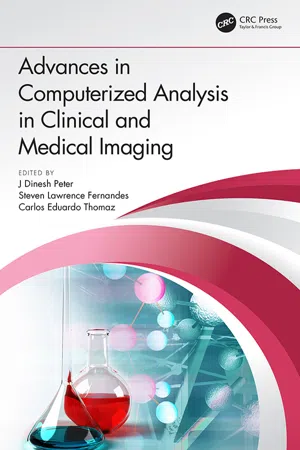
Advances in Computerized Analysis in Clinical and Medical Imaging
J Dinesh Peter, Steven Lawrence Fernandes, Carlos Eduardo Thomaz, J Dinesh Peter, Steven Lawrence Fernandes, Carlos Eduardo Thomaz
- 264 páginas
- English
- ePUB (apto para móviles)
- Disponible en iOS y Android
Advances in Computerized Analysis in Clinical and Medical Imaging
J Dinesh Peter, Steven Lawrence Fernandes, Carlos Eduardo Thomaz, J Dinesh Peter, Steven Lawrence Fernandes, Carlos Eduardo Thomaz
Información del libro
Advances in Computerized Analysis in Clinical and Medical Imaging book is devoted for spreading of knowledge through the publication of scholarly research, primarily in the fields of clinical & medical imaging. The types of chapters consented include those that cover the development and implementation of algorithms and strategies based on the use of geometrical, statistical, physical, functional to solve the following types of problems, using medical image datasets: visualization, feature extraction, segmentation, image-guided surgery, representation of pictorial data, statistical shape analysis, computational physiology and telemedicine with medical images.
This book highlights annotations for all the medical and clinical imaging researchers' a fundamental advances of clinical and medical image analysis techniques. This book will be a good source for all the medical imaging and clinical research professionals, outstanding scientists, and educators from all around the world for network of knowledge sharing. This book will comprise high quality disseminations of new ideas, technology focus, research results and discussions on the evolution of Clinical and Medical image analysis techniques for the benefit of both scientific and industrial developments.
Features:
-
- Research aspects in clinical and medical image processing
-
- Human Computer Interaction and interface in imaging diagnostics
-
- Intelligent Imaging Systems for effective analysis using machine learning algorithms
-
- Clinical and Scientific Evaluation of Imaging Studies
-
- Computer-aided disease detection and diagnosis
-
- Clinical evaluations of new technologies
-
- Mobility and assistive devices for challenged and elderly people
This book serves as a reference book for researchers and doctoral students in the clinical and medical imaging domain including radiologists. Industries that manufacture imaging modality systems and develop optical systems would be especially interested in the challenges and solutions provided in the book. Professionals and practitioners in the medical and clinical imaging may be benefited directly from authors' experiences.